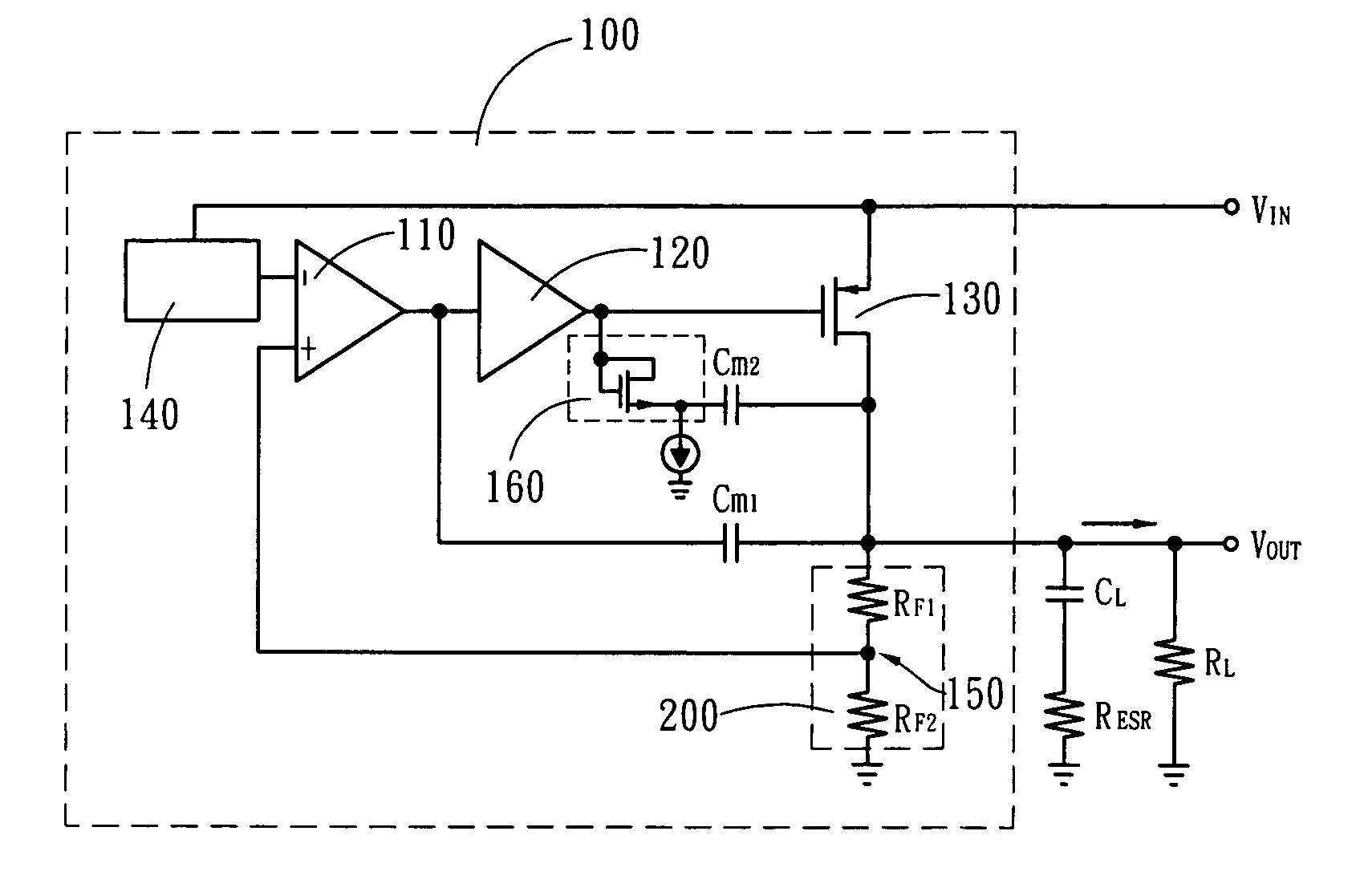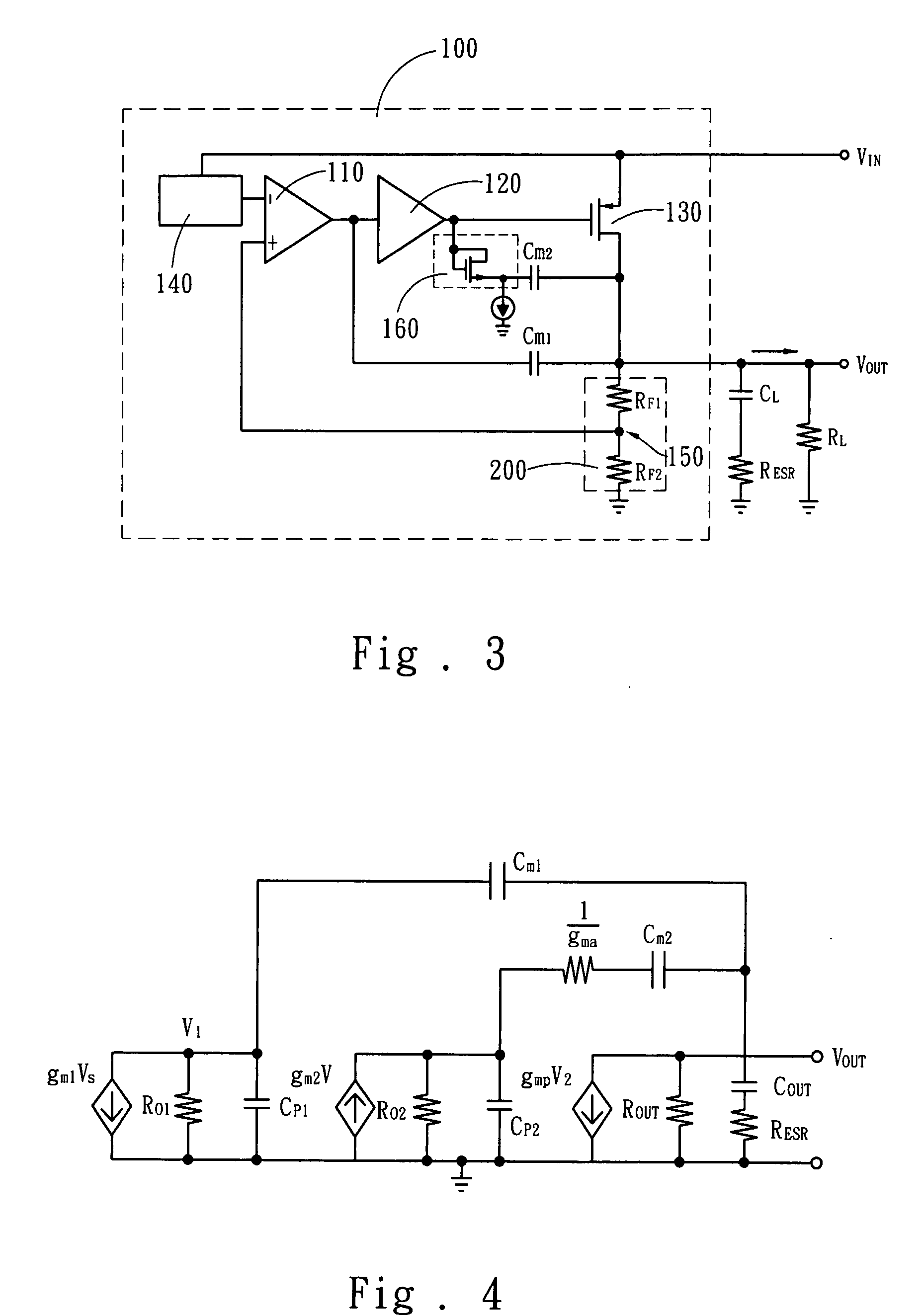[0013]The primary objective of the present invention is to utilize nested Miller compensation and pole-splitting to move the dominant pole to the output of a first-stage
amplifier. Such an approach does not need a big-size output capacitor, and the
system can still have superior stability even under a zero-
capacitance output capacitor. An active
resistor is arranged in the feedback path of a Miller capacitor to increase the
controllability of the damping factor, solve the problem of extensively using the output capacitor with a parasitic resistance, and solve the problem that a compromise must be made between the damping factor control and the system
loop gain.
[0014]Another objective of the present invention is to utilize a capacitor-sharing technique to reduce the Miller
capacitance of the entire system. Thus, the bandwidth can be extended, and the voltage stabilization can be accelerated.
[0016]Based on nested Miller compensation, the present invention utilizes pole-splitting to move the dominant pole to the output of a first-stage
amplifier. Thereby, the system does not need a big-size output capacitor, and the system can still have superior stability even under a zero-capacitance output capacitor, which benefits SOC (
System-on-
Chip) application, reduces circuit board area and decreases external elements. An insufficient damping factor will result in that
frequency response has a surge appearing in the near-by of unit-
gain frequency, and that the
step response of the output voltage to the load current has ripples in the quasi-
linear region; thus, the stabilization is decelerated. The damping factor varies with the output capacitance and the parasitic resistance of the output capacitor. Therefore, the present invention adds an active resistor to the feedback path of the Miller capacitor to increase the
controllability of the damping factor, solve the problem of extensively using the output capacitor with a parasitic resistance, and solve the problem that a compromise must be made between the damping factor control and the system
loop gain.
[0017]The LDO linear
voltage regulator of the present invention further comprises a capacitor-sharing circuit. The capacitor-sharing circuit includes a shared capacitor. The capacitor-sharing circuit detects the current of the power
transistor and switches the shared capacitor to connect in parallel with the first Miller compensation capacitor or the second Miller compensation capacitor. Thereby, the Miller capacitance required by the entire system is reduced, and the stabilization of output voltage is accelerated.
[0019]When the power
transistor operates in the
triode region, the shared capacitor is switched to connect in parallel with the first Miller compensation capacitor to create a greater Miller compensation capacitance to move the dominant pole to
low frequency. In other words, when the load is light, the power
transistor operates in the
triode region, and the shared capacitor is switched to connect in parallel with the first Miller compensation capacitor to create a greater Miller compensation capacitance to move the dominant pole to
low frequency so that the system can has a sufficient phase-angle margin.
[0020]When the power transistor operates in the saturation region, the shared capacitor is switched to connect in parallel with the second Miller compensation capacitor to create a greater Miller compensation capacitance to enhance the controllability of the damping factor. In other words, when the load current persistently increases and the power transistor operates in the saturation region, the shared capacitor is switched to connect in parallel with the second Miller compensation capacitor to create a greater Miller compensation capacitance to enhance the controllability of the damping factor. As there is smaller capacitance in the feedback path of the first Miller compensation capacitor at this time, the bandwidth can be extended when the load is heavy.
 Login to View More
Login to View More  Login to View More
Login to View More 


